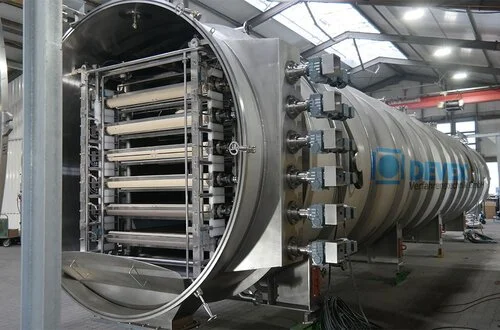FREEZE DRYING
Freeze drying, also known as lyophilization, is a process of removing water from a material by converting ice to vapour under low-pressure circumstances. It is commonly utilized to produce high-quality food and medications. The process involves freezing the material and then removing the ice through drying.
This blog explains the different steps involved in freeze drying, like freezing the product and drying it, along with the issues and how each step works. It also talks about how to pick the right drying methods. The blog covers how process conditions and the properties of the materials affect the final freeze-dried product, including things like its structure, colour, and texture.
Freeze drying is a method that removes water from things like food, biological stuff, and medicines by turning ice directly into vapour without becoming liquid. This process keeps the quality of the dried product intact because freezing the water before drying stops it from spoiling. It helps to preserve the material's flavour, fragrance, and nutrition. Raw food has a lot of water, which is removed during freeze drying to produce a spongy texture in the dried product. When you add water to the dried material, it rapidly rehydrates.
Some of the water in the product freezes during the freeze drying process, while the rest remains adhered to the material and does not freeze. The freeze drying process consists of three steps: freezing the product, converting ice into vapour (sublimation), and finally drying the material to the required humidity.
Choosing the riht conditions for freeze drying is important. If the process is too fast, the product's quality might suffer. For instance, speeding up the drying time can damage the structure or change the properties of sensitive food ingredients. The process conditions should be chosen carefully to avoid melting the water, as liquid water can affect how the product looks, feels, and lasts over time.
The colour and texture of freeze-dried food are important for consumers, so it's crucial to understand how different process settings affect these properties. The process can also impact the nutritional benefits, antioxidant effects, and certain characteristics of food.
Though Freeze drying is seen as a great method, if not done right, it might change the food's appearance, structure, or colour. This review aims to explain each step of freeze drying, talk about what happens during these steps, show how they affect the process, and discuss how the conditions impact different food products.
How does Freeze Drying work
Freeze drying involves three main steps: Freezing, Primary drying (sublimation), and Secondary drying (adsorption).
Freezing
This phase is crucial. It's done in a freezer, chilled bath, or in the freeze dryer itself. The goal is to cool the material below its triple point to turn water into ice. This freezing process preserves the material's physical form by avoiding melting.
Primary Drying (Sublimation)
In this phase, pressure is lowered, and heat is applied to make the frozen water turn directly into vapour (sublimation). The vacuum helps speed up this process. The water vapour sticks to a cold surface (condenser) and turns back into solid form. Around 95% of the water is removed during this step.
Secondary Drying (Adsorption)
This step removes the remaining bound water molecules. By slightly increasing the temperature from the primary drying phase, the remaining bonds between the material and water molecules are broken. The freeze-dried material keeps a porous structure.
After these steps, the vacuum can be replaced with an inert gas, and the dried material is sealed. Most materials end up with a residual moisture content of 1-5%.
Vacuum and Freeze Drying
Freeze drying is a gentle and cost-effective method to remove water from different materials. Low temperatures create a vacuum and evaporate water without changing the product's fragrance, colour, or size. Vacuum Belt Dryers are utilized in several sectors, including medicines, food, and chemicals.
DEVEX Vacuum Belt Dryers work continuously with liquid or solid products. Once dried, the material is removed under cleanroom conditions. After drying, the product can be ground, packed, and prepared for sale.
For smaller productions and lab settings, Vacuum Drying Cabinets are used. These cabinets come in different sizes, from small to large, and are used to dry extracts, powders, or emulsions. Depending on their use, they have heating plates or jackets. Vacuum Drying Cabinets work in batches, handling one set of materials at a time.
Summary and Conclusions
The research on freeze drying mostly focuses on pharmaceuticals. Preserving the biological activity of these products is crucial. Scientists study how each step of freeze drying affects the final product's effectiveness and how it maintains vitamins and other fragile active substances.
Some studies also explore how process conditions affect the physical properties of freeze-dried foods. They look into things like how the product changes in texture and colour during freeze drying, which can tell us about the breakdown of important compounds like antioxidants.
For successful freeze drying, it's important to understand how each stage affects the material being dried. The conditions for freeze drying should match the specific characteristics of the raw material, like its composition, type, and temperature. It's not possible to use the same settings for all foods, so the parameters need to be chosen carefully based on research.
Controlling the heat during the process is crucial to prevent the material from melting or degrading. This helps create a high-quality product by ensuring a shorter drying time and consistent water content throughout the material.
OUR PRINCIPAL
Devex Technology, in collaboration with Kiron Food Processing Technologies, provides a full Freeze Drying Technology for your business needs.
DEVEX Process & Product Development is ready to help with the drying process and dryer design. We have our test centre equipped with a pilot vacuum and freeze drying plant.
Here, we can work on product development, conduct trials using your specific materials and parameters, and then scale up these processes to create custom production equipment. Contact us to learn more about the possibilities










